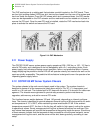
OCPRF100 MP Server System Technical Product Specification
Revision 1.0
16
The PHP mechanism is a rotating part that actuates a switch located on the PHP board. There
are four light emitting diodes (LEDs) per slot--two can be viewed from the rear of the system and
two from inside the system. Once the LED shows which slot is powered down, the PHP mecha-
nism can be depressed on the PHP actuator and the mechanism can be rotated out of place to
remove the PCI card. Once the new PCI card is installed, rotate the PHP mechanism back into
place to activate the switch and secure the PCI card.
Figure 2-14: PHP Mechanism
2.11 Power Supply
The OCPRF100 MP server system power supply operates at 208 - 220 Vac, or 100 - 115 Vac is
rated at 750 watts, and is designed to be hot-swappable, with a 2+1 redundancy factor. Each
power supply has indicators showing correct operation, failure, and predictive failure. A power
supply displaying the predictive failure LED still will operate corectly, but needs to be sent out for
repair as quickly as possible. The predictive failure feature is designed to warn the operator of an
impending power supply failure.
2.12 OCPRF100 MP Server System Chassis
The system chassis is the rack-mount chassis used in the system. The system chassis is
designed to house all of the components listed above within a 7Ux 32” (+/-) deep space, and
mount in a 19-inch rack. The chassis itself is 28” deep with the extra 4” to account for cable man-
agement. The chassis was engineered to provide easy access to perform maintenance,
upgrades, add memory, and add or remove PCI cards.
The functional server weighs between 120 and 140 pounds, depending on internal configura-
tions. The chassis is designed to provide adequate thermal cooling of all devices within an ambi-
ent temperature of 10° to 40°C, while maintaining noise levels below 57 dB. If the ambient
temperature exceeds 30°C, the fans in the fan bay will switch to high speed, cooling the system
to operational values. Server management will log that a thermal excursion has occurred. Sev-
eral internal heat sensors will monitor the temperature at key points inside the server. Should any
of these sensors indicate that the temperature has exceeded a critical thermal set-point, server
management will log the event, and the server will be shut down gracefully, according to user
setup.


















